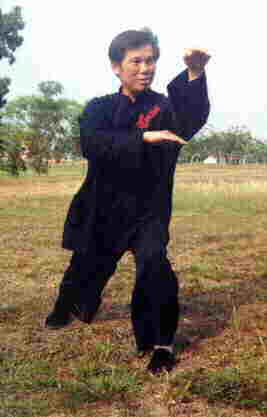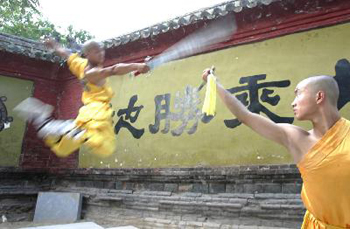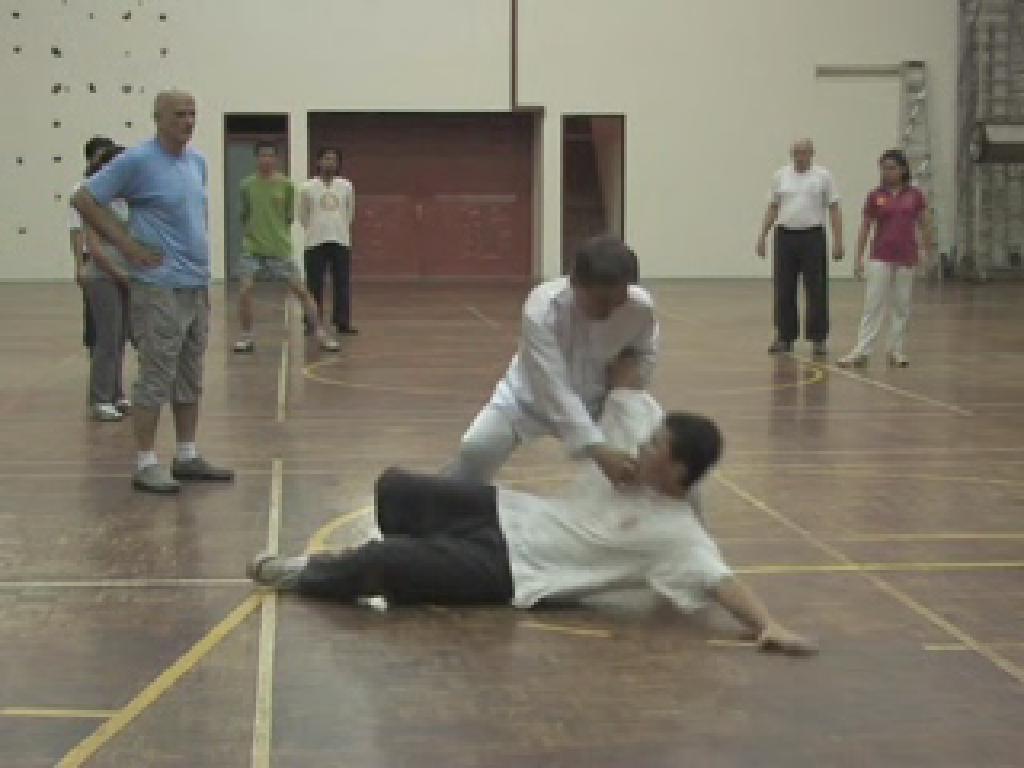January 2008 (Part 1)
SELECTION OF QUESTIONS AND ANSWERS

Wishing all our Guests and Shaolin Wahnam Family Members a Happy and Prosperous 2008

Sifu Wong performing a pattern, "Poisonous Snake Shoots Venom", from Shaolin Kungfu
Question 1
I don't understand! Is Shaolin Kung Fu not being taught in the Shaolin Temple?
— Nicholas, USA
Answer
Indeed, many people are confused. As the Shaolin Temple has been restored by the present Chinese government, when we mention “Shaolin Kungfu”, it is logical that the general public think it is being taught in the modern Shaolin Temple. But the fact is that it is not! This will become clear as you read the answers to your other questions.
Question 2
And if not, where is it being taught?
Answer
To have a good answer, it is necessary to be clear about the question. This may sound odd, but it is where the confusion starts.
The question is “Where is Shaolin Kungfu being taught?” It is very important to be clear about what is meant by “Shaolin Kungfu”. Most people, often without their conscious knowing, accept Shaolin Kungfu by its outward forms. So long as the forms they practice are Shaolin kungfu forms, they regard it as Shaolin Kungfu.
We in Shaolin Wahnam do not stop at the forms. We focus on the benefits, the forms being the means to realize the benefits. To us, Shaolin Kungfu brings combat efficiency, good health and spiritual cultivation. If the forms are Shaolin Kungfu forms but the practice does not bring combat efficiency, good health and spiritual cultivation, then it is not Shaolin Kungfu but just Shaolin Kungfu forms.
It is the same with Taijiquan and chi kung. Many people practice the outward forms of Taijiquan and chi kung, but do not get the benefits these arts are purported to give. To us, they only practice outward Taijiquan forms and outward chi kung forms, but not genuine Taijiquan or genuine chi kung.
If you are contented to accept outward forms as “Shaolin Kungfu”, then it is taught in many places all over the world, including by modern Shaolin monks inside and outside of China.
But still it is not taught in the modern Shaolin Temple. The modern Shaolin Temple has become a very important tourist attraction. Thousands of people visit it every day, and there is just no space to practice “Shaolin Kungfu”. When people said they went to the Shaolin Temple to practice “Shaolin Kungfu”, what they did was to practice modern wushu in the numerous wushu schools around the Temple.
As I have said before, wushu is a magnificent art and it demands much devotion to master it, but it is different from traditional Shaolin Kungfu. Wushu practitioners, for example, do not practice combat application. Some wushu practitioners are formidable fighters, but they use Kick-Boxing or other martial techniques but not wushu or kungfu forms for combat.
Many wushu practitioners sustain injuries, especially knee injuries, from their training. We do not regard this as contributing to good health. Wushu training pays no attention to spiritual cultivation. When wushu was invented by the modern Chinese government, it was meant to be a physical sport.
If you conceptualize Shaolin Kungfu not just by its external forms but by its benefits of combat efficiency, good health and spiritual cultivation, then Shaolin Kungfu is very, very rare today. We are proud to say that we in Shaolin Wahnam are one of these rare schools.
Like what you have said, a lot of people, especially those who are practicing only external Shaolin forms, are not happy to hear my answer. But when I am asked respectfully by sincere persons who want to know, I have to courageously tell the truth as a Shaolin disciple, rather than say pleasant things to please the questioners.
Question 3
Why did the Shaolin Temple stop teaching Shaolin Kung Fu and what are they teaching now? I'm very disappointed to hear this and I'm not sure I want to hear the answers to my new questions.
Answer
Let us look at the historical background. The Shaolin Temple was first built in 495 in Henan Province in north China as an imperial temple. Many hundred years later another Shaolin Temple was built in the south in the city of Quanzhou in Fujian Province by a Ming Dynasty emperor.
When the Qing Dynasty overthrew the Ming, this Quanzhou temple was burnt to the ground. Another southern Shaolin Temple was secretly built on Nine-Lotus Mountain also in Fujian. This second southern temple was also burnt to the ground around 1850 by the Qing Army.
The style of kungfu that originated from the northern Shaolin Temple in Henan is referred to as Northern Shaolin, whereas that from the two southern Shaolin Temples in Fujian as Southern Shaolin. When one talks about the burning of the Shaolin Temple by the Qing Army which resulted in the spread of Shaolin Kungfu out of the Temple, many people mistakenly think it was the northern Shaolin Temple. This is incorrect.
It was the southern Shaolin Temple that was burnt, and it was burnt not once but twice as there were two southern Shaolin Temples, an open one in Quanzhou and a secretive one on the Nine-Lotus Mountain. In the first burning, the Qing Army was helped by Lama kungfu experts from Tibet who used the infamous “flying guillotines”. The second burning by the Qing Army was led by Pak Mei, who was a Shaolin grandmaster but sided with the Qing.
The northern Shaolin Temple in Henan remained throughout the Qing Dynasty. It was burnt by rival warlords in 1928, 17 years after the Chinese Republic had overthrown the Qing Dynasty in 1911. The burning of the northern Shaolin Temple in 1928 had nothing to do with Shaolin Kungfu.
Even before the burning of the northern Shaolin Temple in Henan in 1928, Shaolin Kungfu was no longer taught there. During the time of the Chinese Republic, 1911 to 1945, the Henan Shaolin Temple, or what remained of it after the 1928 burning, was deserted.
When the present Chinese People's Republic took over in 1945, practicing any traditional arts, like kungfu, chi kung, painting and music, was considered bourgeois, and therefore taboo in a Communist country. The worst period was during the Cultural Revolution in the 1960s when practicing any traditional arts was considered counter-revolutionary, the most serious crime in the country at that time.
Happily when the modern Chinese leader Deng Xiao Ping regained power in the 1970s, China began to open its doors to the world, and conditions changed drastically which eventually led China to become a great economic power today. The present Chinese government promotes kungfu, which is called “wushu” in China, not as a martial art but as a sport. It is not practiced in its traditional styles like Praying Mantis, Eagle Claw, Hoong Ka, Choy-Li-Fatt or Wing Choon, but collectively as wushu.
The Shaolin Temple in Henan was rebuilt, after Jet Li's firm, “Shaolin Temple”, had made the name “Shaolin” world famous. The Temple soon became a very successful tourist attraction. The Shaolin master, the Venerable Hai Deng, was invited to the Shaolin Temple to teach traditional Shaolin Kungfu, but he soon left, probably due to policy differences.
Meanwhile a lot of wushu schools mushroomed around the Shaolin Temple, teaching wushu as a sport. Some of the wushu instructors were modern Shaolin monks seconded from the Temple, some merely put on monk's robes.
Later “sanda”, which means “free sparring” but was actually Kick-Boxing in this modern Chinese context, was introduced. Recently the wushu schools around the Temple were moved to other places. Wushu teams were sent to various countries for demonstration. Some of these wushu exponents, amongst them some modern Shaolin monks, broke away from their teams and remained to teach their art.

Students of Songshan Shaolin Wushu Vocational School perform exercises outside the Shaolin Temple today in Dengfeng, China. This is the first Wushu school in China, and is known as the cradle of Wushu champions. The picture is reproduced from People's Daily Online at http://english.peopledaily.com.cn/200407/07/eng20040707_148763.html
Question 4
I am an assistant instructor at my Kung Fu School. We teach Southern Hung Gar and a lost art that my Sifu calls the “crawl”
I have practiced Master Wong Kiew Kit's Chi Kung for over a year now and would like to deepen my understanding. I have studied Master Wong Kiew Kit's books and have become fairly competent with the movements and visualizations, yet I have a lot more to learn and meditate on, and an intensive training course would surely benefit me.
I am wondering how to become certified to teach Master Wong Kiew Kit's Chi Kung. I saw that there was an intensive Chi Kung course, does this certify one to teach Chi Kung under Master Wong Kiew Kit's lineage or was this course developed just to deepen the students understanding of energy and/or to make sick people well?
— Greg, USA
Answer
Both my Intensive Chi Kung Course as well as my Intensive Shaolin Kungfu Course are meant for the students' own practice, and not meant to train instructors.
Actually they are our elementary courses. Those who have attended the courses, if they further qualify, may be invited to continue with other more advanced courses, like the Small Universe Course and the Special Shaolin Kungfu Course. These more advanced courses are by invitation only, and not open to the public.
Those who have shown good result in their attainment as well as character, and if they are interested, may be invited to undergo training to be Shaolin Wahnam instructors. The onus is on us to select prospective instructors to preserve our arts. We do not entertain anyone who comes to us and say that he (or she) wants to become an instructor.
Although our Intensive Chi Kung Course and Intensive Shaolin Kungfu Course are our first courses, many of those who have attended, including many masters and a few grandmasters in their own right, consider these courses very advanced. It is expected that course participants attain in a few days of the course what most other practitioners may not attain in many years.
Others who have no direct exposure to what we practice in these courses, may accuse us of being boastful or attack us for belittling other schools. It is our policy to regard their opinions as their business, and we do not want them to be our students.
What are the things that our course participants accomplish, not just learn, in a few days what others may not attain in many years? In our Intensive Chi Kung Course, our participants are able to tap energy from the Cosmos, generate an internal energy flow, enjoy a cosmic shower, use energy to massage internal organs, and direct energy to flow to wherever they want in their body.
In our Intensive Shaolin Kungfu Course, participants are able to enter Zen, generate an energy flow, develop internal force, apply Shaolin patterns for sparring, and spar for a few hours without panting for breath or feeling tired.
These attainments are not just mentioned but tangible. Participants can measure by the end of the course whether they have achieved these abilities. Indeed, some of our instructors who have prior experience in other schools, have expressed amazement that we teach such skills so openly in our first courses.
Question 5
Perhaps my question is a little frivolous. I'm going to play a short theatre play with two women. Each actress weighs about 150 pounds. In one act of the play I have to lift them at the same time (one in each arm) and to leave the stage (10 meters, more or less) with them in my arms.
I practice chi-kung since January 2007 and I´ve read two of your excellent books,“The Art of Chi Kung” and “Chi Kung for Health and Vitality”. With my young instructor we think that a good exercise to get the strength necessary to lift and carry these women is repeat the movement of lifting the women slowly several times, feeling in my arms the imaginary weight of the two women (a kind of “pushing mountains” but with the arms lifting and no pushing, and with a little of effort, imagining -- “feeling” -- the women´s weight in my arms. Is this correct? Is this possible? Are we wrong?
— Joaquin, Argentina
Answer
The method suggested by you and your young instructor is not necessarily incorrect but is very unlikely to produce the result you want. It is possible for you to practice your method but it is nearly impossible to be successful. You are not totally wrong but continuing with your suggested method would be unwise.
There is a better method where you are quite sure of success. It is called the “Art of Carrying a Pig”. It demands some effort and takes some time to accomplish, but the prospect of carrying two women in your arms, especially if they are pretty and provided that you like them, may act as a good incentive. It is also recommended that you don't let them know your training method.
The training method is as follows. Buy two piglets and feed them everyday. Every morning lift one in each hand and walk about with the piglets in your hands or arms for about half an hour.
The piglets grow very fast. In a few months they will have become very big and heavy. But the increase in their weight per day is gradual. If you carry them everyday without fail, you would not feel the increase of their weight. You would then be able to lift two beautiful actresses easily.
This method was successfully used by some kungfu practitioners in the past. It was, however, not a popular art, possibly because there weren't many actresses waiting to test the result.
The accomplishment of this art and any art of force training depends on two important principles, namely consistent practice and gradual progress.

Combat application is not a normal part of modern wushu training, but it is in traditional Shaolin Kungfu.
Question 6
I'm afraid that I'm not able to view the video clips on the website. When I download them and try to view them through windows media player all I get is the sound of the video clip and a big still musical sign displayed, no video.
Are you able to offer me any advice so that I will be able to view the video clips please?
— Mark, USA
Answer
The problem probably lies with not having the correct “Codec”.
Please go to my webpage on Video Galore and download “Window Media Player” or “DivX” or “Codec DivX 5.2.1.” or all the three. You should then be able to enjoy viewing the videos.
You can also find useful information on the thread Broken Links/Corrupted Video Files in our Shaolin Wahnam Discussion Forum.
Question 7
I practice a Tibetan chi kung set in the evening along with the Shaolin kung fu training I do in the morning. Lee Wei Joo and I discussed this and although I follow the rules of both schools respectfully and do not mix and match on my own we still felt it was a good idea to ask you if you felt this system was compatible with our school. My goal is to be a high level warrior healer and if you honestly feel that I will reach a higher level by practicing Shaolin exclusively than I will do so.
I also attended an "Art of Living” course that taught me a set of breathing exercises called pranayama that I planned to do in the morning before my Shaolin practice.
— Ray, USA
Answer
Provided that you practice them correctly, it is alright to combine the Tibetian chi kung set and the pranayama breathing you have learnt elsewhere with our Shaolin training. But the issue is not whether these arts are compatible. The issue is whether you will get the best benefits, especially with reference to the sacifice made and the aim realized.
Instead of giving a direct answer, it is more fun to give you an analogy and let you decide for yourself.
Suppose you aim to become a lawyer, and you are already enrolled in the Harvard Law School. You attended a seminar on Native Indian Laws, and another on Medieval English Laws. Would you spend time studying all the three law systems? You may, if you like, but it is not a very wise thing to do.
You have to make a choice. If your aim were to become an expert in Native Indian Laws or Medieval English Laws, you would then focus on your choice, and read some Laws from the Harvard Law School during your leisure for fun.
But your aim is to become a lawyer in the United States, and you are already enrolled in one of the finest institutions in the world. You may read some Native Indian Laws and Medieval English Laws for fun, but it is unwise to devote equal time on all the three.
Even if you can excel in all the three, your accomplishment as a lawyer will be affected. In other words, even if you can still become a good lawyer despite spending a lot of time on Native Indian Laws and Medieval English Laws, you would be a better lawyer by focusing on your aim instead of diverting twice the time on something else.
It is also worthy of note that your dedicated study at the Harvard Law School will be more than sufficient to make you into a good lawyer. You don't need to supplement your study with other courses. Should Native Indian Laws, Medieval English Laws or any other studies are needed, they will be provided for in your course in Harvard.
Question 8
Is it alright to practice the Tibetan chi kung set and the pranayama breathing exercises?
Answer
If you decide to practice the Tibetan chi kung set or the pranayama breathing exercises, an important issue is whether you are able to practice them correctly. You may have learnt them correctly, but whether you can continue to practice them correctly on your own is another question.
The Tibetian chi kung set you have described is based entirely on visualization. If you practice incorrectly, and it is easy to do so often without you knowing, it can bring serious adverse effects. Although you did not describe the pranayama breathing exercises, I know that they involve sophisticated breathing methods. It is also easy to practice them wrongly and have adverse effects.
Practicing the Shaolin arts that you have learnt from Shaolin Wahnam is different. You may also make mistakes in your practice, but there are safety precaution already in-built in our exercises that automatically overcome any side-effects you may have developed in your wrong practice. The most important of this safety precaution is our chi flow.
If you have developed some adverse effects as a result of practicing our exercises incorrectly, the chi flow which is an intergral part of the exercise will clear the adverse effects without you having to perform any special remedial exercises. This is a fantastic advantage not found in most other schools.
You should note that the incorrect practice mentioned here is due to mistakes made because of forgetfulness or carelessness. If a student purposely goes against the instruction, then it is a different matter. He is obviously asking for trouble for himself. One very important instruction in our school is not to worry and not to intellectualize during practice.
Another question you should ask yourself is what benefits you can get from practicing the Tibetan chi kung set or the pranayama breathing exercises that you cannot get from our Shaolin arts. If there are extra benefits which you would like to have, then go ahead and practice them, but bear in mind that these extra benefits will be obtained at the expense of the time you have to take away from your Shaolin training or from other aspects of your life.
If you do not have any extra benefits, you should then ask whether it is more cost-effective to get these same benefits by practicing the Tibetan chi kung set or the pranayama exercises. You should ascertain that the benefits are the same, and not just some of the benefits are the same. For example, by practicing pranayama breathing you can he healthy, but by practicing Shaolin Kungfu you can be both healthy and combat efficient. The benefits are not exactly the same.
If it is more cost-effective to obtain the same benefits by practicing the Tibetan chi kung set, pranayama exercises or any other arts than by practicing our Shaolin arts, then it is only logical that you practice them instead of our Shaolin arts.
The Buddha said that his teaching was like a raft to ferry you from the shore of suffering to the shore of bliss. If you could find a better raft, by all means use it. Of course we are nowhere near the Buddha, but we aspire to his philosophy. We use our methods because we find them the best available to help us achieve our goals. If we find some better methods, we would use the better methods.
LINKS
Selected Reading
- The Ultimate Technique
- The Amis and Objectives of Practicing Kungfu
- The Spear against the Versatile Three-Sectional Staff
- Handling a Boxer Competently Despite his Speed and Size
- The Amazement and Effectiveness of Monkey Kicks
